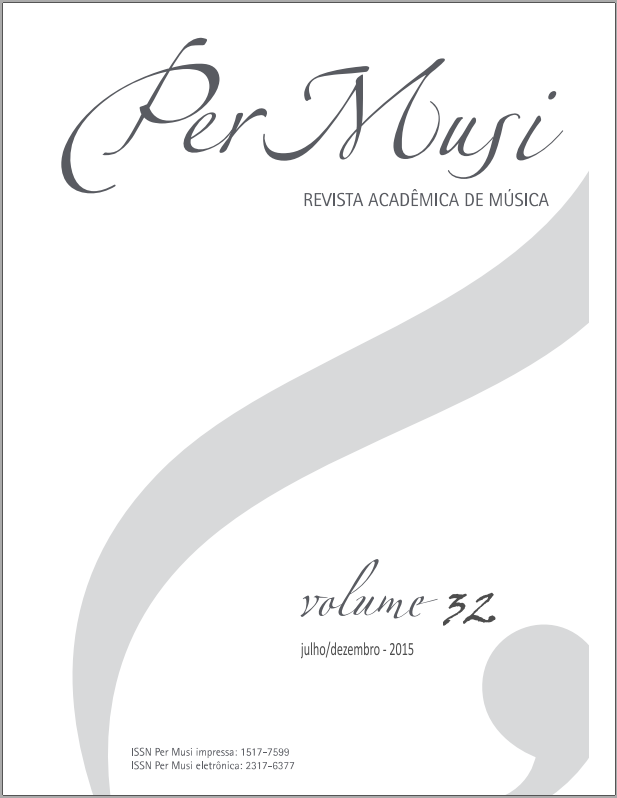Images of Brazil in the 20th-century classical music
reflections about Brazilian cultural identities
Keywords:
Cultural identity, Brazilian culture, Contemporary music, Brazilian musicAbstract
This article discusses the process of image construction in the elaboration of the cultural identity expressed in the Brazilian classical music during the twentieth century. Conceptual issues related to the narrative, image creation, and cultural identity essential tothe understanding of Brazilian culture as a system of cultural representationsare discussed. Central references on the emergence ofsignificant relationships between certain musical materials and elements of the Brazilian culture (SALLES, 2005; KATER, 2001; CONTIER, 1978)are outlined. Departingfrom the definitionsof subject, identity, sense of belonging, culture and national identity, it explainsthe process of narrative and image construction around a national cultural identity. Finally,it aims atunderstandingthe relativity of the collective self-images (REZENDE, 2009; ORTIZ, 1994) that have been made present in the Brazilian classical music in that period.
References
CANÇADO, T.L. (2000). “O fator atrasado na música brasileira: evolução, características e interpretação”. Per Musi. Belo Horizonte: UFMG. n.2, p.5-14.
CONTIER, A.D. (1978). Música e Ideologia no Brasil. São Paulo: Novas Metas.
DOTTORI, M. (2005). “As ideias e a música: influências europeias na música brasileira”. Anais do colóquio Brasil musical. Paraná: De Artes - UFPR.
FREITAG, L.V. (1985). Momentos de Música Brasileira. São Paulo: Nobel.
HALL, S. (2006). A identidade cultural na pós-modernidade. 11ª ed. Rio de Janeiro: DP&A, 2006.
KATER, C.E. (2001). Música Viva e H. J. Koellreutter: movimentos em direção à modernidade. São Paulo: Musa Editora; Atravez.
MARTINEZ, J.L. (2006). “Brasilidade e Semiose Musical”. Revista Opus. Campinas: ANPPOM. nº12, p.114-131.
NEGWER, M. (2009). Villa-Lobos: o florescimento da música brasileira. São Paulo: Martins Fontes.
NEVES, J.M. (1981). Música Contemporânea Brasileira. São Paulo: Ricordi Brasileira.
ORTIZ, R. (1994). Cultura Brasileira e Identidade Nacional. 4ª ed. São Paulo: Brasiliense.
REZENDE, C. (2009). Retratos do estrangeiro: identidade brasileira, subjetividade e emoção. Rio de Janeiro: FGV.
RIBEIRO, D. (1992). A Fundação do Brasil: testemunhos 1500-1700. Petrópolis: Vozes.
SALLES, P.T. (2005). Aberturas e Impasses: o pós-modernismo na música e seus reflexos no Brasil (1970 – 1980). São Paulo: UNESP.
SANTOS, E.P. (2006). “Uma Viagem até a Brasilidade: romance pós-moderno e pós-colonial e romance indianista brasileiro”. Revista Letras de Hoje. Porto Alegre. v.41, n.3, p.185-200.
VIANNA, H. (2010). O Mistério do Samba. 7ª ed. Rio de Janeiro: Zahar: UFRJ.
WISNIK, J.M. (2004). “Getúlio da Paixão Cearense: Villa-Lobos e o Estado Novo”. In: Música: o nacional e popular na cultura brasileira. Reimp. 2º ed. São Paulo: Brasiliense.
Downloads
Published
Issue
Section
License
Copyright (c) 2015 Per Musi

This work is licensed under a Creative Commons Attribution 4.0 International License.

Except where otherwise noted, contents on this site are licensed under a Creative Commons - Atribuição 4.0 Internacional.


